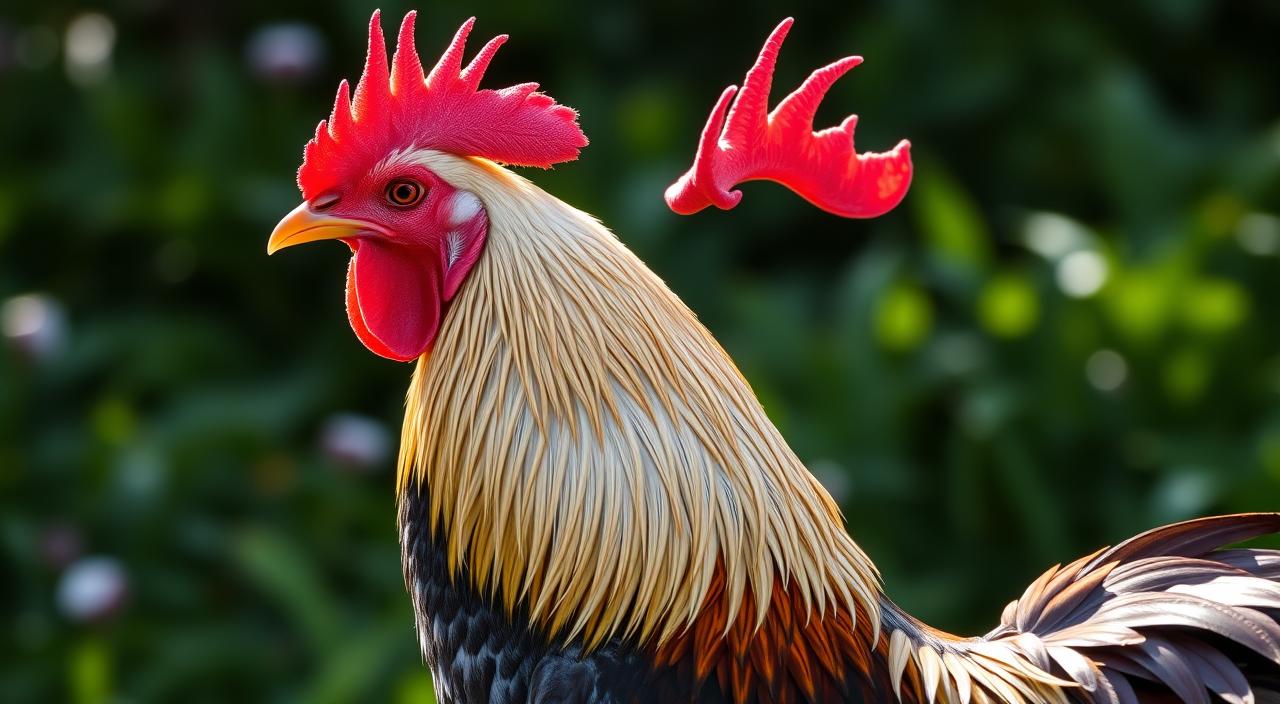Polish chickens are a distinctive breed that fascinates poultry fans worldwide. Their eye-catching crests and diverse color patterns make them stand out. Over 17 years, these ornamental chickens have become popular among backyard farmers and show exhibitors.
In November 2006, the Crossroads of America Poultry Show displayed over 340 Polish chickens. This event highlighted the breed’s growing appeal. The Polish Breeders Club in the U.S. has boosted their popularity for ornamental value.
Polish chickens come in many colors, including black, blue, cuckoo, buff, and partridge. They also have gold, chamois, and silver varieties. These birds have small to medium-sized bodies and clean legs.
Their distinctive crest of feathers makes them unique in any flock. Polish hens can lay 150 to 200 eggs yearly. They’re not known for high egg production.
These gentle and curious birds typically weigh 4-6 pounds. They have a lifespan of 5-8 years. Their unique appearance requires extra care to prevent eye infections.
Despite this challenge, Polish chickens remain a beloved choice. They’re perfect for those wanting a striking and friendly addition to their backyard flock.
The Fascinating History of Polish Chickens
Polish chickens have a rich history as one of the oldest poultry breeds. Their unique look and charming personality have won over chicken lovers for centuries.
These birds stand out with their captivating appearance. They’ve become a favorite among chicken enthusiasts worldwide.
Ancient Origins and European Roots
Polish chicken history stretches back to ancient times. A stone statue in the Vatican shows a crested fowl, hinting at their early existence.
Archaeological evidence supports their ancient origins. A skull found in southern England suggests Romans spread these birds across Europe.
Introduction to the United States
Polish chickens arrived in America and were well-established by 1850. The American Poultry Association recognized them in 1874.
Various bearded and non-bearded varieties were added through 1963. These ancient breeds quickly gained popularity among breeders nationwide.
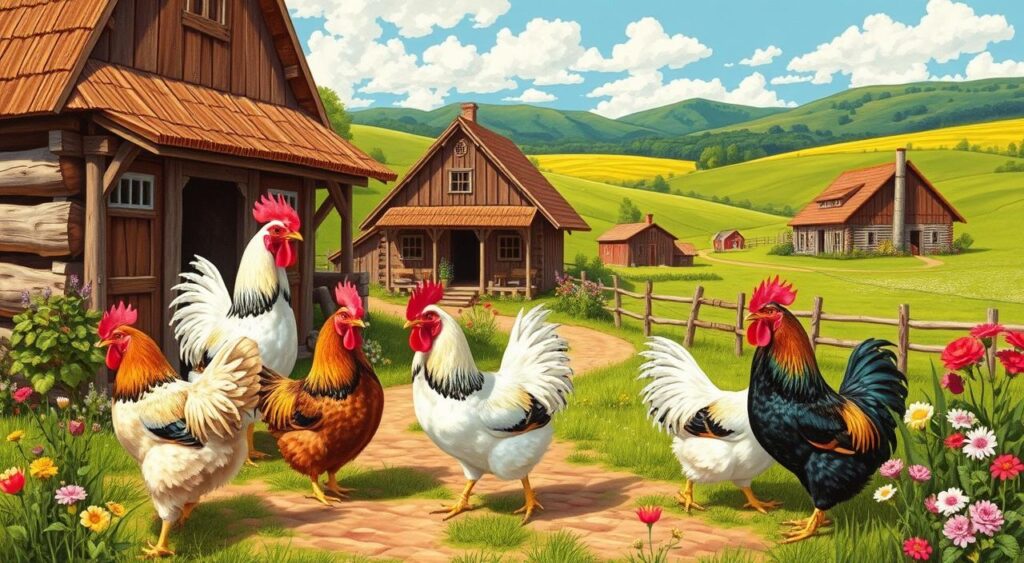
Evolution of the Breed Standard
Polish chickens have evolved into distinct varieties over time. The American Poultry Society recognizes several color patterns.
These include White Crested Black, Golden, Silver, and White in both bearded and non-bearded forms. Non-standard colors like White Crested Blue Splash and Chocolate add diversity.
| Characteristic | Details |
|---|---|
| Weight (Full-size) | Roosters: 6 lbs, Hens: 4.5 lbs |
| Egg Production | 150-200 eggs per year |
| Egg Color | White (some varieties cream or tinted) |
| Lifespan | 5-8 years |
| Crest Feather Length | Over 3 inches |
Polish chickens were once prized for egg production in 18th-century Europe. Today, they’re beloved pets and show birds, known for their distinctive crest.
Their meat is less commonly used but can add a unique touch to dishes. For those curious about polish chicken recipes, they offer a special culinary experience.
Distinctive Features of Polish Chickens
Polish chickens are unique ornamental poultry with a striking appearance. Their most notable feature is the large crest of feathers on their heads. This fluffy pom-pom gives them a charming and elegant look.
These birds come in various feather colors, including white, black, and buff-laced. Some varieties have facial feathering called a beard. Their upright posture and clean legs add to their regal bearing.
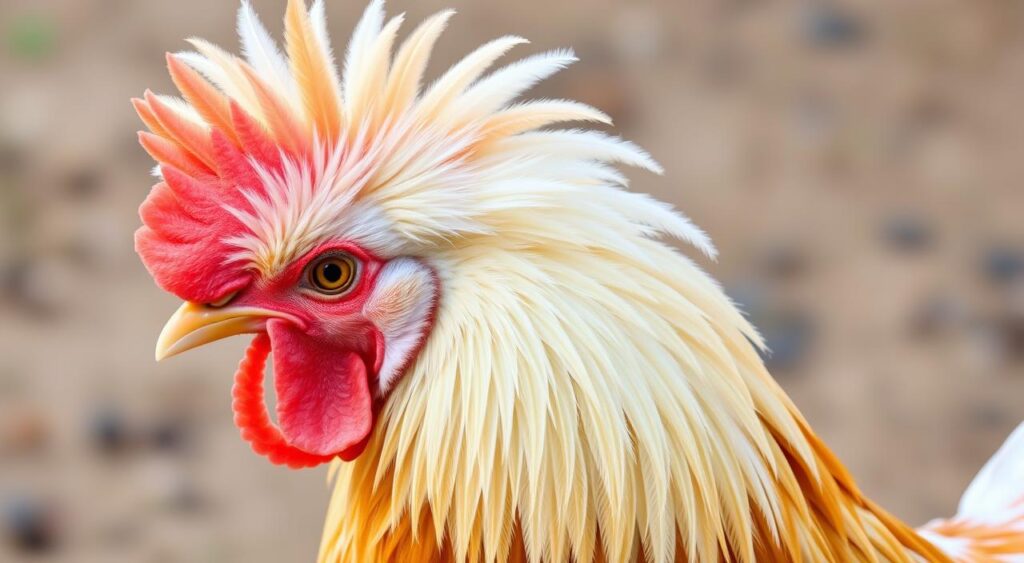
Polish chickens are small to medium-sized birds. Hens typically weigh 4-5 pounds, while roosters reach 5-6 pounds. Their crest feathers can cover their eyes, affecting vision and making them vulnerable to predators.
| Characteristic | Description |
|---|---|
| Crest | Large, fluffy feathers on top of head |
| Feather Colors | White, black, buff-laced, silver-laced, golden-laced, blue |
| Posture | Upright and elegant |
| Legs | Clean, without feathering |
| Size | Small to medium |
Polish chickens are popular among poultry fans who love their unique looks. Their ornamental value often outweighs their egg-laying abilities. Many choose them as eye-catching backyard companions for their gentle nature.
Polish Chicken Varieties and Colors
Polish chickens are a fascinating breed with many varieties and colors. These unique birds are popular among chicken enthusiasts and backyard poultry keepers. Their striking appearance and gentle nature make them stand out.
These ornamental birds have become favorites for their distinctive looks and mild temperament. Their diverse colors and patterns add flair to any flock.
Recognized Varieties in the US
The United States recognizes ten polish chicken varieties. Each has its own distinct characteristics. These include the Non-Bearded White, Non-Bearded Silver, and Bearded Buff Laced.
| Variety | Beard Type | Color Pattern |
|---|---|---|
| White Crested Black | Non-Bearded | Black body, white crest |
| Golden | Bearded | Golden laced feathers |
| Silver | Bearded | Silver laced feathers |
Popular Color Patterns
Polish chickens have an array of stunning color patterns. Some popular varieties include silver laced, white-crested black, and buff laced. These vibrant colors make Polish chickens truly eye-catching.
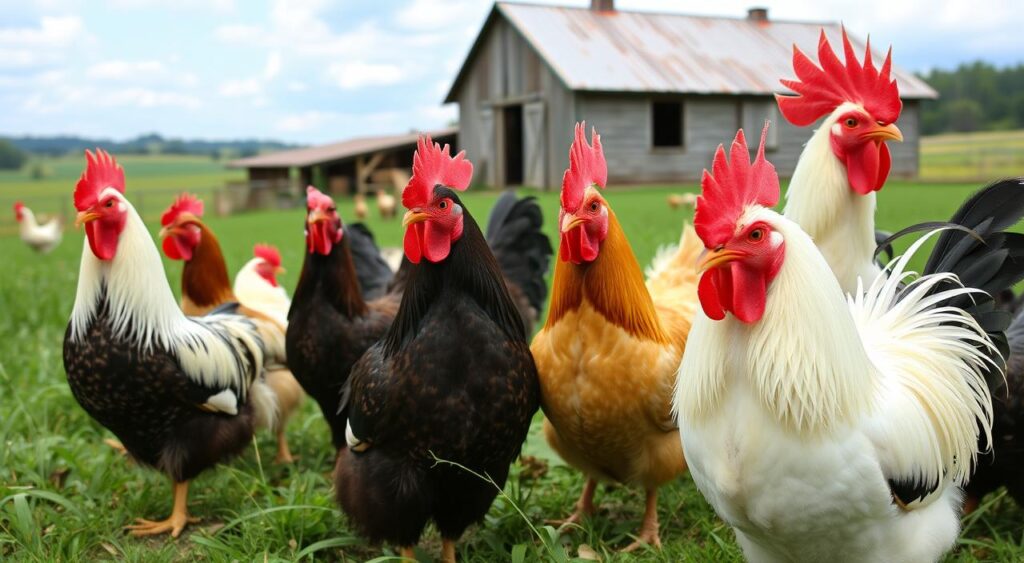
Frizzle and Bantam Variants
Frizzle and bantam variants offer even more unique Polish chicken options. Frizzle Polish chickens have curled feathers, adding extra visual appeal. Bantam Polish are smaller versions of the standard breed.
Bantam roosters weigh around 1.8 lbs, while hens weigh about 1.6 lbs. These smaller sizes make them perfect for those with limited space.
Temperament and Personality Traits
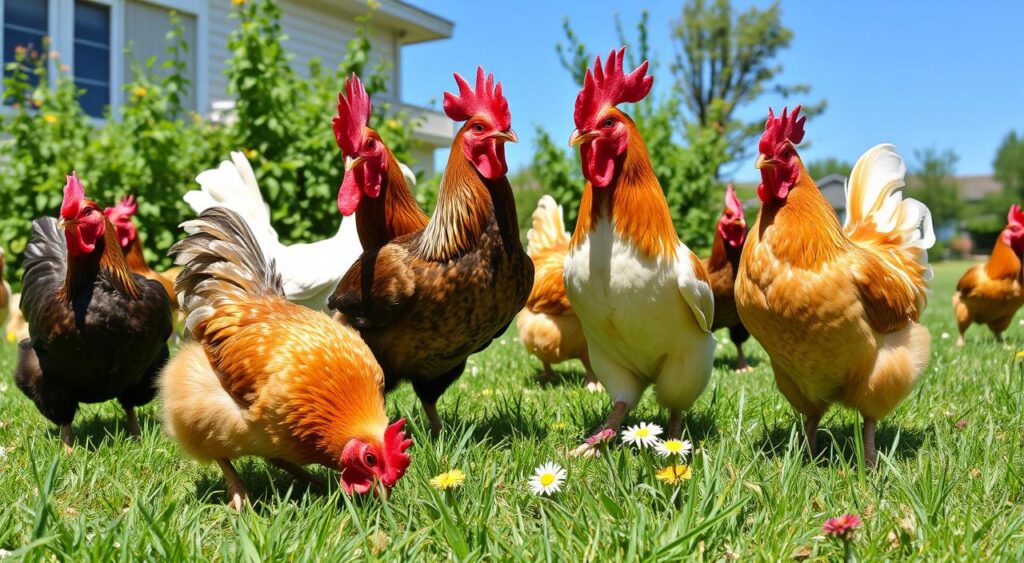
Polish chickens are gentle and friendly, perfect for backyard enthusiasts. They have shapely figures with full breasts and large wings. Their feathery crests are eye-catching but can limit their vision.
These birds are docile and non-aggressive. They love foraging and staying active. However, their limited sight can make them easily startled.
Polish chickens are social and get along well with other breeds. They’re great for families, especially those with children. These birds often form strong bonds with their caretakers.
“Polish chickens are like the glamorous divas of the poultry world – beautiful, a bit high-maintenance, but absolutely lovable.”
Polish chickens aren’t prolific egg layers. They produce about 150-200 medium white eggs yearly. Their rarity as broody hens gives them more time with their human families.
Polish Chickens as Backyard Pets
Polish chickens are popular backyard pets due to their unique looks and gentle nature. They offer a mix of charm and companionship. These family-friendly birds make excellent pets for those seeking something special.
Suitability for Families
Polish chickens are perfect for family settings. Their calm nature and low aggression make them ideal for peaceful backyards. They’re a manageable size, with hens weighing 4.5 lbs and roosters 6 lbs.
Interaction with Children
These birds are great with kids due to their gentle nature. Children love watching their distinctive crests and lively personalities. Polish chickens handle petting well, making them perfect for introducing poultry to young ones.
Compatibility with Other Breeds
Polish chickens get along well with other docile breeds. Their peaceful nature helps create a harmonious flock. However, their unique head feathers can make them targets for pecking.
- Tolerate confinement well
- Moderate noise level
- Poor foraging ability
- Require protection from predators
Polish chickens lay 2-4 eggs per week, which is moderate. They’re mainly show birds, recognized by the American Poultry Association. These chickens come in various colors like Buff Laced and Silver Laced.
Egg Production and Quality
Polish chickens are moderate egg layers, producing 150-200 eggs yearly. Their unique looks and friendly nature make up for lower egg counts. These ornamental birds are perfect for backyard flocks.
Hens start laying around 6 months old. Their eggs are white and range from tiny to medium. To get a dozen eggs weekly, you’d need about 4 Polish hens.
Polish chickens lay 3-4 eggs per week. They’re great for small-scale farming or families wanting fresh eggs. Their egg production stays steady year-round, with slight seasonal changes.
| Breed | Eggs per Year | Egg Color | Egg Size |
|---|---|---|---|
| Polish Chicken | 150-200 | White | Tiny to Medium |
| Rhode Island Red | 300+ | Brown | Large |
| Leghorn | 300+ | White | Large |
Polish chicken eggs are prized for their quality. The yolks are rich and flavorful, perfect for traditional dishes. Their moderate egg production suits small-scale farming and sustainable agriculture.
Care and Maintenance of Polish Chickens
Polish chickens need special care due to their unique crest. Their distinctive feature requires extra attention to keep them healthy. Let’s look at how to care for these special birds.
Crest Care and Grooming
Polish chickens’ crests need regular cleaning and trimming. This helps prevent eye infections and keeps their vision clear. The large crest can attract pests, so check it often.
Gently wash and carefully trim crest feathers. This helps maintain their health and appearance.
Housing Requirements
Polish chickens need secure, predator-proof coops. Each bird requires at least 4 square feet of space in the chicken house. These birds don’t do well in cold, so protect them from damp conditions.
Use dust-free shavings for bedding to protect their eyes and breathing. Keep feeders and drinkers in the same spots to help with their limited vision.
Feeding Guidelines
Use narrow-lipped drinkers and pellet feed for Polish chickens. This keeps their crest clean and dry. Polish chickens lay about 150 eggs yearly, so they need a balanced diet.
Make sure they always have fresh water and quality feed. This meets their nutritional needs and helps them live longer, healthier lives.
- Provide pellet feed to keep crest clean
- Use narrow-lipped drinkers to prevent wet crests
- Offer balanced nutrition for egg production
- Ensure constant access to fresh water
Follow these tips to give your Polish chickens great care. They’ll be healthy and happy in your flock.
Health Considerations for Polish Chickens
Polish chickens need special care for their health. Their unique crest can cause problems. Regular eye checks are vital to spot issues like redness or swelling.
The crest can collect dirt and moisture. This makes Polish chickens prone to diseases. Cleaning and parasite prevention are key. Their limited vision also makes them easy targets for predators.
Polish chickens live 5-8 years and weigh 4.5 to 6 pounds. They’re not broody, making egg collection simple. These birds lay 3-4 eggs weekly, totaling 150-200 yearly.
Polish chickens can face health issues like water on the brain. Their calm nature puts them low in the pecking order. With proper care, they can thrive in any flock.
Breeding and Showing Polish Chickens
Polish chickens stand out in the poultry world. Their eye-catching crests and graceful looks make them show favorites. Breeding these birds can be tricky, but mastering their standards brings great rewards.
Breeding Challenges and Strategies
Breeding Polish chickens needs careful planning. They rarely brood, so artificial incubation or surrogate hens are needed. Breeders must also watch color combinations to keep breed standards.
- Silver laced and golden laced varieties should be kept separate to avoid color dilution
- White crested black can be bred with white crested chocolate for diverse offspring
- Mixing blue and chocolate varieties is not recommended
Preparing for Poultry Shows
Crest care is key when prepping Polish chickens for shows. Good grooming can make a big difference in competitions. Polish hens weigh 4-5 pounds, while roosters are 5-6 pounds.
Judging Criteria for Polish Chickens
Judges look at specific features in Polish chickens. The crest is crucial, with size, shape, and quality being important. Body shape and color patterns also matter in scoring.
| Feature | Importance | Key Points |
|---|---|---|
| Crest | High | Size, shape, symmetry |
| Body Conformation | Medium | Posture, proportions |
| Color Patterns | Medium | Adherence to breed standard |
| Overall Appearance | High | Cleanliness, vigor |
The Future of Polish Chickens in Poultry Farming
Poland’s poultry farming is growing fast. Nearly 1,300 industrial farms operate now. Two new farms open monthly, with 32 added in 2023-2024 alone.
Polish chickens stand out in the breed world. They charm enthusiasts with their unique looks. The American Poultry Association recognized them in 1874.
These birds come in various colors. Bearded White and Non-Bearded Golden are popular varieties. Their striking appearance keeps interest in conservation efforts high.
Polish chickens’ role in farming might change. Once prized for eggs, they now serve ornamental purposes. Hens used to lay about 200 eggs yearly.
Large farms like Wróblewo house millions of broilers. This makes preserving diverse chicken breeds crucial. It helps maintain poultry biodiversity for the future.
